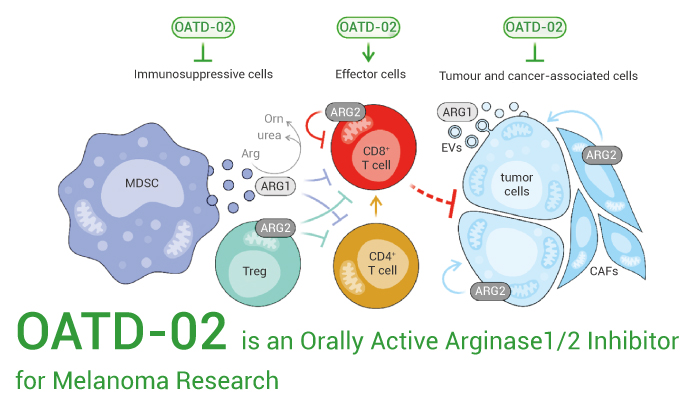Nowadays, Checkpoint inhibitors for cancer therapy have shown great benefits. Besides, amino acid metabolism is important in the regulation of the immune response. As the critical enzymes in metabolic pathways, arginases catalyzes the hydrolysis of L-arginine into L-ornithine and urea. Importantly, arginases regulate the fitness of both immune and tumor cells. They drives multiple immunosuppressive mechanisms and tumor-specific metabolic adaptations. In addition, arginases can promote the immune escape of cancer cells, and inhibits T cell proliferation and activation. There are two distinct isoforms of arginase, Arginase 1 (ARG1) and Arginase 2 (ARG2). Therefore, ARG1 and ARG2 inhibitors have great potential in anticancer research. Moreover, OATD-02 is a potent, selective, orally active, competitive and reversible dual inhibitor of ARG1 and ARG2. OATD-02 can be used for melanoma research.

OATD-02, a selective and orally active dual inhibitor of ARG1 and ARG2, can be used for multiple myeloma research.
In vitro, OATD-02 blocks recombinant arginases with IC50s of 20 nM (hARG1), 39 nM (hARG2), 39 nM (mARG1), and 28 nM (rARG1), respectively. OATD-02 also shows potent inhibition efficiency in several cell lines. Specifically, OATD-02 inhibits mARG in BMDM cells with IC50 of 912.9 nM and hARG2 in transfected CHO-K1 cells with IC50 of 171.6 nM.
In vivo, OATD-02 shows antitumor effect in the B16F10 orthotopic xenograft tumor model. Specifically, OATD-02 (50 mg/kg, twice per day, oral gavage) inhibits the tumor growth with TGI value of 46%. OATD-02 also increases fourfold of the L-arginine concentration in plasma sustained even 1 week after end. Besides, OATD-02 (10 mg/kg, oral gavage) displays a favorable pharmacodynamic effect in vivo, with oral bioavailabilities of 13%, 30%, and 61% in mouse, rat, and dog, respectively.
In conclusion, OATD-02 is a selective and orally active dual inhibitor of ARG1 and ARG2. Noticeably, OATD-02 inhibits tumor growth in B16F10 orthotopic xenograft tumor model. Therefore, OATD-02 can be used for research of multiple myeloma.
References:
[1] Borek B, et al. Mol Cancer Ther. 2023 Jul 5;22(7):807-817.
[2] Grzybowski MM, et al. 2022 Aug 17;14(16):3967.